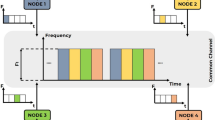Abstract
High propagation delays cause message collisions at intended nodes, which seriously affects network performance. In this paper, we consider the transmission scheduling problem of messages with specified transmission requirements, which is ignored by most MAC protocols of Underwater Acoustic Networks (UWANs). We focus on the actual applications of UWANs and adopt time-domain interference alignment to design a scheduling algorithm (TDIA-MAC). Firstly, we study the nature and the existence conditions of perfect scheduling. Secondly, we analyze the constraints required for feasible transmissions and design the value function to evaluate feasible transmissions. The optimal decision is selected from feasible transmissions by the value function. The algorithm meets the message transmission requirements in practical applications and ensures that multiple nodes can work simultaneously without conflicts. Finally, we simulate the proposed algorithm under two settings of varying offered traffic and the number of nodes. The results show that the TDIA-MAC outperforms the other three algorithms in terms of throughput, successful delivery ratio, and fairness under varying offered traffic and the number of nodes.







Similar content being viewed by others
References
Kao C C, Lin Y S, Wu G D, et al. (2017) A study of applications, challenges, and channel models on the Internet of Underwater Things. In: 2017 International conference on applied system innovation (ICASI)
Jiang S (2017) State-of-the-art medium access control (MAC) protocols for underwater acoustic networks: a survey based on a MAC reference model. IEEE Commun Surv Tutor 20(1):96–131
Luo H, Wu K, Ruby R, et al. (2018) Software-defined architectures and technologies for underwater wireless sensor networks: a survey. IEEE Commun Surv Tutor 20(4):2855–2888
Liu Y, Liu A, Zhang N, et al. (2019) DDC: dynamic duty cycle for improving delay and energy efficiency in wireless sensor networks. J Netw Comput Appl 131:16–27
Lee J, Kim S (2020) EnRI-MAC: an enhanced receiver-initiated MAC protocol for various traffic types in wireless sensor networks. Wirel Netw 26(2):1193–1202
Liu G, Yan S, Mao L (2020) Receiver-only-based time synchronization under exponential delays in underwater wireless sensor networks. IEEE Internet Things J 7(10):9995–10009
Han M, Duan J, Khairy S, et al. (2020) Enabling sustainable underwater IoT networks with energy harvesting: a decentralized reinforcement learning approach. IEEE Internet Things J 7(10):9953–9964
Yang J, Qiao G, Hu Q, et al. (2020) A dual channel medium access control (MAC) protocol for underwater acoustic sensor networks based on directional antenna. Symmetry 12(6):878
Han Y, Fei Y (2016) DAP-MAC: a delay-aware probability-based MAC protocol for underwater acoustic sensor networks. Ad Hoc Netw 48:80–92
Zhuo X, Qu F, Yang H, et al. (2019) Delay and queue aware adaptive scheduling-based MAC protocol for underwater acoustic sensor networks. IEEE Access 7:56263–56275
Zhu M, Zhang W, Jin N, et al. (2015) UPMAC: a localized load-adaptive MAC protocol for underwater acoustic networks. IEEE Sens J 16(11):4110–4118
Li C, Xu Y, Xu C, et al. (2015) DTMAC: a delay tolerant MAC protocol for underwater wireless sensor networks. IEEE Sens J 16(11):4137–4146
Liao W H, Huang C C (2011) SF-MAC: a spatially fair MAC protocol for underwater acoustic sensor networks. IEEE Sens J 12(6):1686–1694
Chitre M, Motani M, Shahabudeen S (2012) Throughput of networks with large propagation delays. IEEE J Ocean Eng 37(4):645–658
Zeng H, Hou Y T, Shi Y, et al. (2014) SHARK-IA: an interference alignment algorithm for multi-hop underwater acoustic networks with large propagation delays. In: Proceedings of the international conference on underwater networks & systems, pp 1–8
Molins M, Stojanovic M (2006) Slotted FAMA: a MAC protocol for underwater acoustic networks. In: OCEANS 2006-Asia Pacific. IEEE, pp 1–7
Zhang R, Cheng X, Cheng X, et al. (2017) Interference-free graph based TDMA protocol for underwater acoustic sensor networks. IEEE Trans Veh Technol 67(5):4008–4019
Yang T C (2015) Spatially multiplexed CDMA multiuser underwater acoustic communications. IEEE J Ocean Eng 41(1):217–231
Yu H, Yao N, Cai S, et al. (2013) Analyzing the performance of Aloha in string multi-hop underwater acoustic sensor networks. EURASIP J Wirel Commun Netw 2013(1):1–10
Zhang Y (2014) Performance of p-persistent slotted Aloha for underwater sensor networks. In: 2014 International conference on computing, networking and communications (ICNC). IEEE, pp 583–587
Liao Z, Li D, Chen J (2015) A handshake based ordered scheduling MAC protocol for underwater acoustic local area networks. Int J Distrib Sens Netw 11(1):984370
Guan Z, Kulhandjian H, Melodia T (2020) Stochastic channel access in underwater networks with statistical interference modeling. IEEE Trans Mob Comput, pp 1–1
Liu M, Huang W, Qian L, et al. (2016) An improved R-MAC based MAC protocol for underwater acoustic networks. In: 2016 IEEE international conference on signal processing, communications and computing (ICSPCC). IEEE, pp 1–6
Sivakumar V, Rekha D (2018) Node scheduling problem in underwater acoustic sensor network using genetic algorithm. Pers Ubiquitous Comput 22(5–6):951–959
Keshanchi B, Souri A, Navimipour N J (2017) An improved genetic algorithm for task scheduling in the cloud environments using the priority queues: formal verification, simulation, and statistical testing. J Syst Softw 124:1–21
Ghobaei-Arani M, Souri A, Safara F, et al. (2020) An efficient task scheduling approach using moth-flame optimization algorithm for cyber-physical system applications in fog computing. Trans Emerg Telecommun Technol 31(2):e3770
Alfouzan F, Shahrabi A, Ghoreyshi S M, et al. (2018) An efficient scalable scheduling MAC protocol for underwater sensor networks. Sensors 18(9):2806
Author information
Authors and Affiliations
Corresponding author
Additional information
Publisher’s note
Springer Nature remains neutral with regard to jurisdictional claims in published maps and institutional affiliations.
Thanks to China National Natural Science Foundation for funding, No.61671169. Thanks to Research fund of Talents of QuanZhou City, No.2018C109R.
Rights and permissions
About this article
Cite this article
Zhao, N., Yao, N. & Gao, Z. A message transmission scheduling algorithm based on time-domain interference alignment in UWANs. Peer-to-Peer Netw. Appl. 14, 1058–1070 (2021). https://doi.org/10.1007/s12083-020-01058-2
Received:
Accepted:
Published:
Issue Date:
DOI: https://doi.org/10.1007/s12083-020-01058-2




